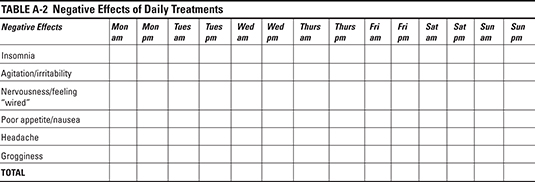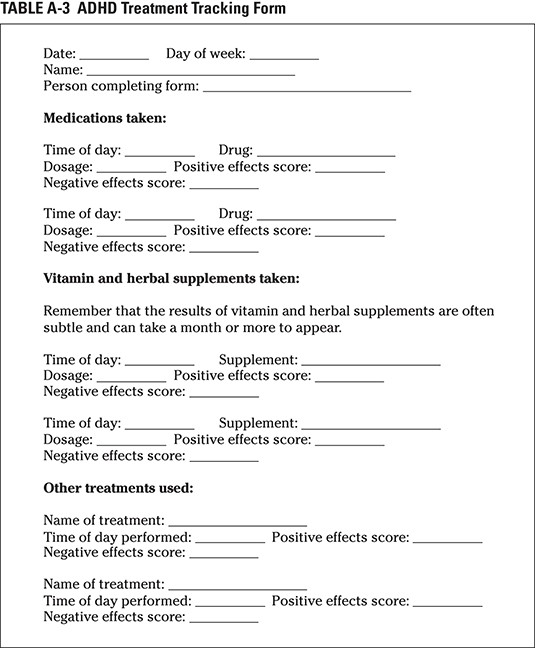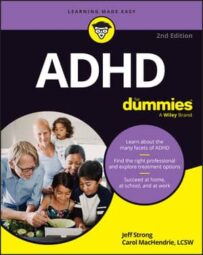The three types of ADHD
ADHD looks different in almost everyone. You may have problems regulating yourself if you’re dealing with ADHD. This can happen in areas of attention, behavior, and motor movements. The term attention deficit/hyperactivity disorder comes from the American Psychiatric Association’s Diagnostic and Statistical Manual of Mental Disorders (now in its fifth edition), which outlines three basic types of ADHD:
-
Predominantly inattentive type. Having this type of ADHD means that you have difficulty focusing but are able to sit still. Classic symptoms include these:
-
Making careless mistakes
-
Not seeming to listen as someone else speaks
-
Being disorganized or forgetting things
-
Having trouble focusing on a specific task
-
-
Predominantly hyperactive/impulsive type: If you have this type of ADHD, maintaining attention is less of a problem than being able to control your body movements or behaviors. The basic symptoms include the following:
-
Speaking or acting out of turn
-
Not considering consequences before acting
-
Fidgeting or feeling restless when trying to sit
-
Being excessively physically or verbally active
-
-
Combined type: If you have several symptoms from both the inattentive and hyperactive/impulsive lists, you may have the combined type of ADHD.
To have ADHD, your symptoms must meet certain guidelines, including:
-
Existing for at least six months
-
Appearing before you were 12 years old
-
Having a significant impact on your life in more than one setting
-
Not being attributable to a different condition (such as bipolar disorder)
Secondary symptoms of ADHD
ADHD is not limited to the classic (or primary) symptoms of inattention, impulsivity, and hyperactivity. Many other (secondary) symptoms exist that can negatively impact your life, including, but not limited to, the following:
-
Worry
-
Boredom
-
Loss of motivation
-
Frustration
-
Low self-esteem
-
Sleep disturbances
-
Hopelessness
-
Procrastination
-
Difficulty getting along with others
-
Difficulty managing time or money
Treatment levels for ADHD
A variety of ways exist to treat ADHD symptoms, but treatment has to be addressed from three levels: biological, psychological, and social. This combined, or multimodal, treatment approach is the most effective way to deal with ADHD.
Biological
Biological treatments change the way your brain works. The change can be accomplished several ways and can be temporary or permanent, depending on the approach you take. The options include:
-
Medication
-
Diet
-
Vitamin supplements and herbal remedies
-
Neuromodulation therapies, such as neurofeedback, rhythmic entrainment intervention, and auditory integration training
-
Rebalancing therapies, such as homeopathics, acupuncture, sensory integration therapies, vision therapy, and manipulation therapies (osteopathy, chiropractic, and CranioSacral Therapy).
Psychological
Psychological therapies help you deal with the feelings that come from your symptoms and understand how to change the way you think and act to improve your life. Psychological treatment strategies can include the following:
-
Counseling and psychotherapy, such as insight-oriented therapy, supportive therapy, play therapy, skills training, psychoeducational counseling, and parent training
-
Behavior management, such as behavior modification, cognitive-behavioral therapy (CBT), and awareness training
Social
Everyone needs certain skills in order to function in the world, but people with ADHD often struggle with basic life strategies. After you deal with the biological issues associated with ADHD, you need to start developing your social skills in the following areas:
-
Organization
-
Relationships
-
Communication
-
Lifestyle choices
-
Occupational skills
Track your treatment
Treating ADHD effectively often involves juggling more than one treatment at a time, and adjustments need to be made on a regular basis. For this reason, you must have a way to keep track of your progress and any side effects from the treatments. (This point is especially important if you include medication in your treatment strategy.) The following forms can help.
Complete these ADHD Treatment Effectiveness Checklists each day of the week, both morning and evening, to rate the positive and negative effects of your treatments on a scale of 1 to 10 (with 1 meaning poor results, 5 meaning acceptable, and 10 meaning excellent). Total your score for each time of day.


Use the following ADHD Treatment Tracking Form to note your total scores from the checklists for that treatment’s positive and negative effects.


